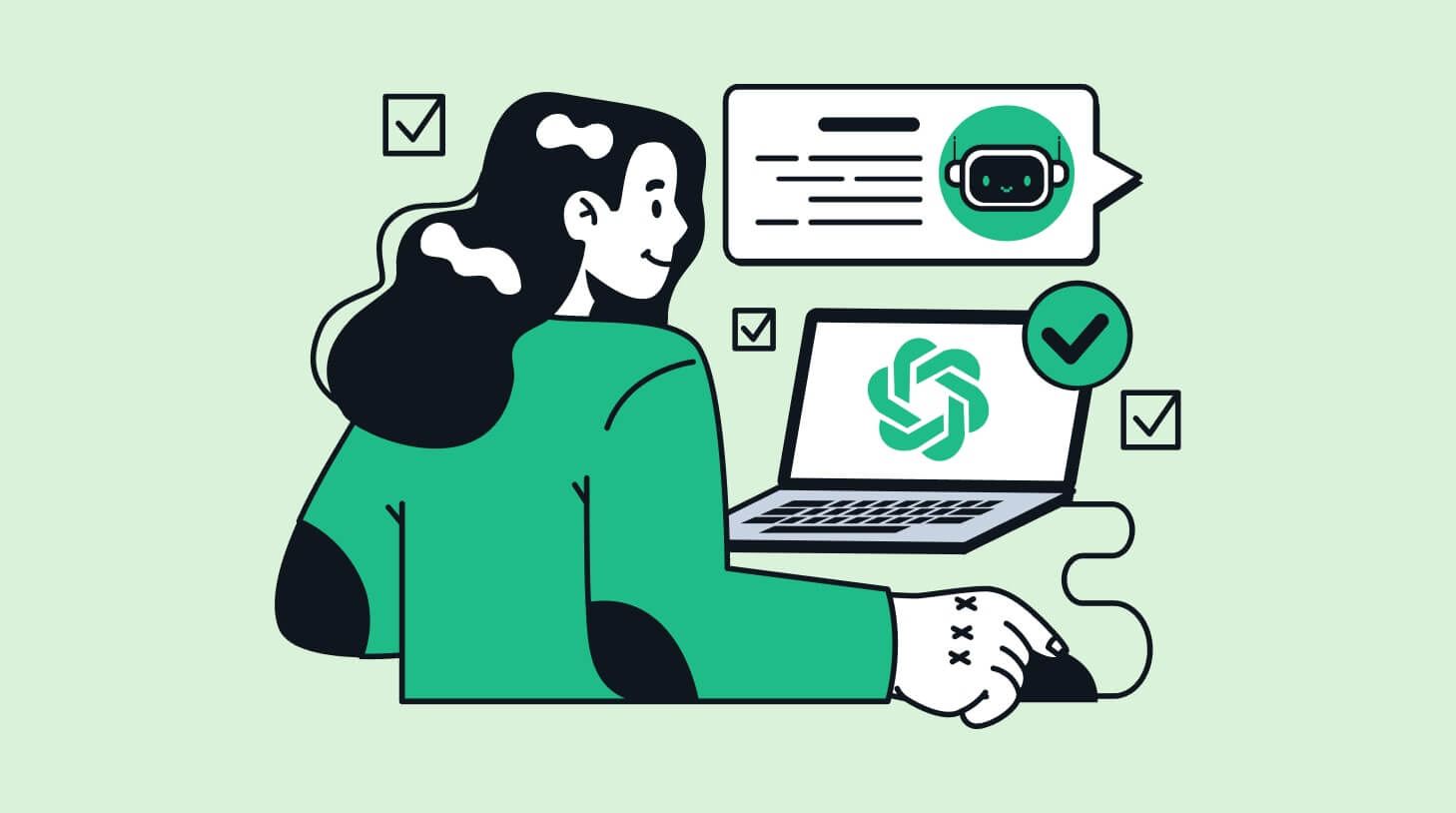How to overcome bias with ChatGPT: a complete guide
Learn to use ChatGPT for blind resume screening, standardized interviews, and employee feedback analysis, fostering a diverse, equitable workplace.

As an HR professional, you should seek to be as fair and unbiased as you can during the hiring process. Sadly, this is more of an ideal to strive for than an attainable standard. We all have biases. We all come with expectations shaped by our past experiences.
You naturally assume things about a person based on their race, their skin color, their first language, how much education they have, and how they present their outward gender.
It’s not your fault. You can’t help it. All of us do that. It’s how people are socialized.
AI tools, and ChatGPT in particular, offer you an interesting solution to this common HR challenge – that of overcoming your own unconscious bias in the hiring process.
ChatGPT is a tool that humans created, and its training data is not free of its own biases. That notwithstanding, ChatGPT can help you identify and remove various forms of bias from your own HR processes. You just need to know what to ask it.
This post will explore how you can use ChatGPT to overcome bias in a way that leads to a more equitable, diverse, and inclusive workplace, and offer use cases and example prompts for doing so.
Related: Can AI help beat unconscious bias in hiring? Yes, it can
Contents
The role of AI in overcoming HR bias
One of the things that AI tools do best and better than any human being can on their own is analyze large amounts of data, and identify patterns and trends that would be lost on an average human.
AI tools like ChatGPT can scan job descriptions, performance reviews, and candidate profiles and highlight where biases might occur.
That analysis can help you make a more fair hiring process. It makes the candidate hiring process more impartial and objective.
That isn’t to say that ChatGPT isn’t free from its own biases. Human beings make AI tools, and their training data is influenced by the same unconscious biases that their creators have. ChatGPT itself has gender bias that can affect the outcome of HR tasks.
Even so, ChatGPT and other AI tools can still be incredibly useful for you for finding and removing bias as an HR professional.
You just have to be aware of their limitations and use your own human judgment.
ChatGPT use cases for overcoming bias
ChatGPT’s versatility and adaptability mean you can do more or less anything you want with it. Its processing capabilities mean that it can pick up on minute details that you would miss on your own, and detect biases that you can’t.
Here are some of the ways you can use ChatGPT to detect and remove bias.
1. Blind resume screening
How much can you learn about a person just from their resume alone?
Alongside the skills and qualifications that help you decide whether a candidate is a potentially good fit for the role you’re trying to fill, their resume will also have their name, location, where they went to school, their area and zip/postal code, and other personal identifiers. These can influence your decision-making process in ways you’re not even fully aware of.
Use ChatGPT to anonymize the resume you’re scanning to swipe details like names, addresses, and educational institutions that might reveal their gender, race, and socioeconomic background.
Example prompt: Summarize the work experience and skills of this candidate without including any personal demographic information
2. Standardized interview questions
Every single person you interview will be given the same set of interview questions, delivered in the same way. However, each one of those candidates will be different.
You can use ChatGPT to ensure a consistent interview process in a way that focuses solely on the candidate’s skills and experiences. That helps keep the interview process fair across the board.
Try something like:
Example prompt: Generate a list of skill-based interview questions for a software engineering position ChatGPT
Or something a little more specific:
Example prompt: Create behavioral interview questions that assess problem-solving abilities for a project manager role.
Then, you can take those interview questions, and use the AI-powered Workable interview question generator to customize them into something more unique to the role and your company culture.
3. Bias training for HR staff
ChatGPT can be a handy learning tool for both you and your staff in recognizing the way biases influence your decisions and choices when sourcing and recruiting candidates.
You can use it to develop HR training modules for you and your team and simulate scenarios that help you address your biases, so you can work around them.
Educating yourself about bias isn’t just about awareness, but using tools and creating strategies that counteract biases altogether in day-to-day decision-making.
Create realistic scenarios and interactive training sessions where you and the rest of your HR team can identify and address bias in a controlled environment.
For instance, you can have ChatGPT make a training module that focuses on gender bias in hiring decisions. The module can include scenarios where gender bias might influence your hiring decision, and include questions and discussion points to help your staff find them.
Example prompt: Create a training module for an HR team on identifying and mitigating gender bias in hiring decisions
You can make training modules for racial bias as well.
Example prompt: Develop a scenario-based exercise to train HR staff in recognizing racial bias in performance evaluations. Make a detailed scenario, give the step-by-step training exercises, and make a detailed list of questions and discussion points.
4. Employee feedback analysis
HR teams rely on employee feedback to improve how they find, hire and let go of people. Manually sifting through a mountain of employee feedback forms on your own is not only time-consuming but can be affected by your own subjective interpretations and analysis.
ChatGPT can help you process large volumes of employee responses and feedback efficiently, and give actionable insights from them.
For example, if bias against a particular group is found in a certain department, your HR team can do a more in-depth investigation and intervention.
Example prompt: Summarize the key concerns related to diversity and inclusion from this employee survey
You can even have ChatGPT scan the employee feedback responses for workplace bias and identify problem areas:
Example prompt: Analyze these employee feedback responses and identify any recurring themes related to workplace bias
5. Job description optimization
You can start to remove gender and racial bias from your interview process at the very beginning.
How do you do that? You can have ChatGPT make neutral job descriptions that bring in a broad, diverse range of talent and appeal to a wider candidate pool.
Use ChatGPT to create job descriptions that avoid language that might unconsciously defer to certain groups or ethnicities.
Example prompt: Rewrite this job description to ensure it is gender-neutral and inclusive for all candidates
Or here’s an alternate take on the same prompt.
Example prompt: Identify and replace any potentially biased language in this job advertisement with more inclusive wording
Addressing ChatGPT’s own biases
ChatGPT is a tool made by people with their own biases, who trained it on data made by people who in turn have their own biases. AI tools are a reflection of the people who made them.
OpenAI, the company that makes ChatGPT, has addressed this issue in its FAQ section on the subject of ChatGPT bias. They call for the need for human oversight when reviewing any content or output made by ChatGPT.
Some things to be aware of:
- The model is skewed towards Western views
- The model might agree with a user’s strong opinion on political issues and reinforce them
- The model performs best in English
Strategies for ChatGPT bias mitigation
You can use several strategies to mitigate the biases in ChatGPT’s own training:
- Regular auditing: Audit ChatGPT for potential biases. Review the recommendations that AI tools give you and check them for patterns that demonstrate bias
- Human oversight: Create a system of human oversight where ChatGPT’s decisions are reviewed by trained human HR professionals
- Continuous learning: As AI tools evolve, incorporate learning and feedback from diverse datasets to help gradually reduce their bias
- Transparency: Be open about the role of AI in your decision-making, and the measures taken to ensure fairness and objectivity
Make your hiring and recruiting bias-free with ChatGPT
Using ChatGPT, you can anonymize your resumes, create unbiased job applications, scan for gender and racial bias in your surveys and employee feedback, and even train your HR team to be aware of their own bias.
Just keep in mind that AI tools are not perfect and are impacted by the bias of their creators. Create systems and processes that account for that, minimizing their limitations and maximizing their potential.
If you want to dive deeper into this topic, check out our guide to checking for unconscious bias when screening candidates.
Frequently asked questions
- How can AI help in reducing bias in HR processes?
- AI tools like ChatGPT can impartially analyze resumes, ensuring a focus on skills and qualifications. They can generate unbiased interview questions and evaluate employee feedback, identifying patterns of bias. This helps create a fairer hiring process, based on merit rather than subjective biases.
- What are some specific ways ChatGPT can be used to overcome bias in hiring?
- ChatGPT can be utilized for blind resume screening, removing personal details that might lead to bias. It can also aid in creating standardized interview questions that focus solely on a candidate's abilities. Additionally, it can help in developing training modules for HR staff to recognize and mitigate their own biases.
- How can HR professionals ensure they are using AI responsibly?
- HR teams should conduct regular audits of AI outputs for potential biases and ensure the AI is trained on diverse data sets. Maintaining human oversight in decision-making processes and being transparent about AI usage are also crucial for responsible AI implementation in HR.
- Can ChatGPT address its own inherent biases?
- While ChatGPT, like any AI, may have inherent biases due to its training data, steps can be taken to mitigate them. Regular auditing, continuous learning from diverse datasets, and human oversight can help reduce the impact of these biases. OpenAI, the creator of ChatGPT, also emphasizes the importance of transparency in the use of AI tools.
- What impact can bias-free AI have on workplace diversity and inclusion?
- By minimizing bias in hiring and recruitment processes, AI tools like ChatGPT can contribute to a more diverse and inclusive workplace. They help ensure that job opportunities are accessible to a broader range of candidates, fostering an environment where diversity is valued and biases are continuously addressed.











